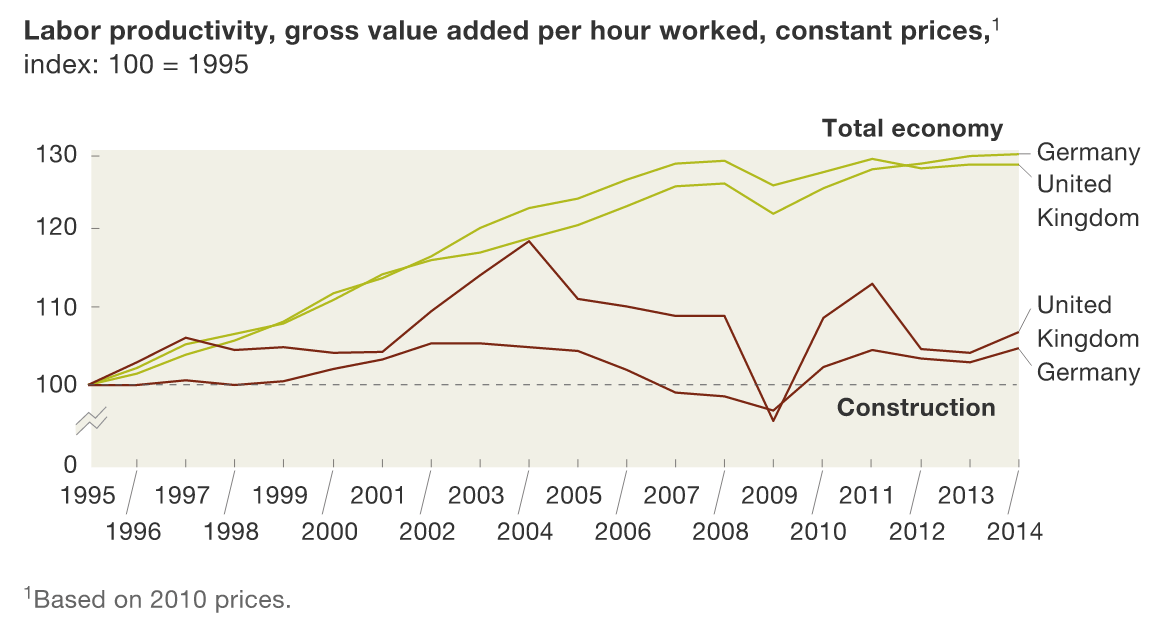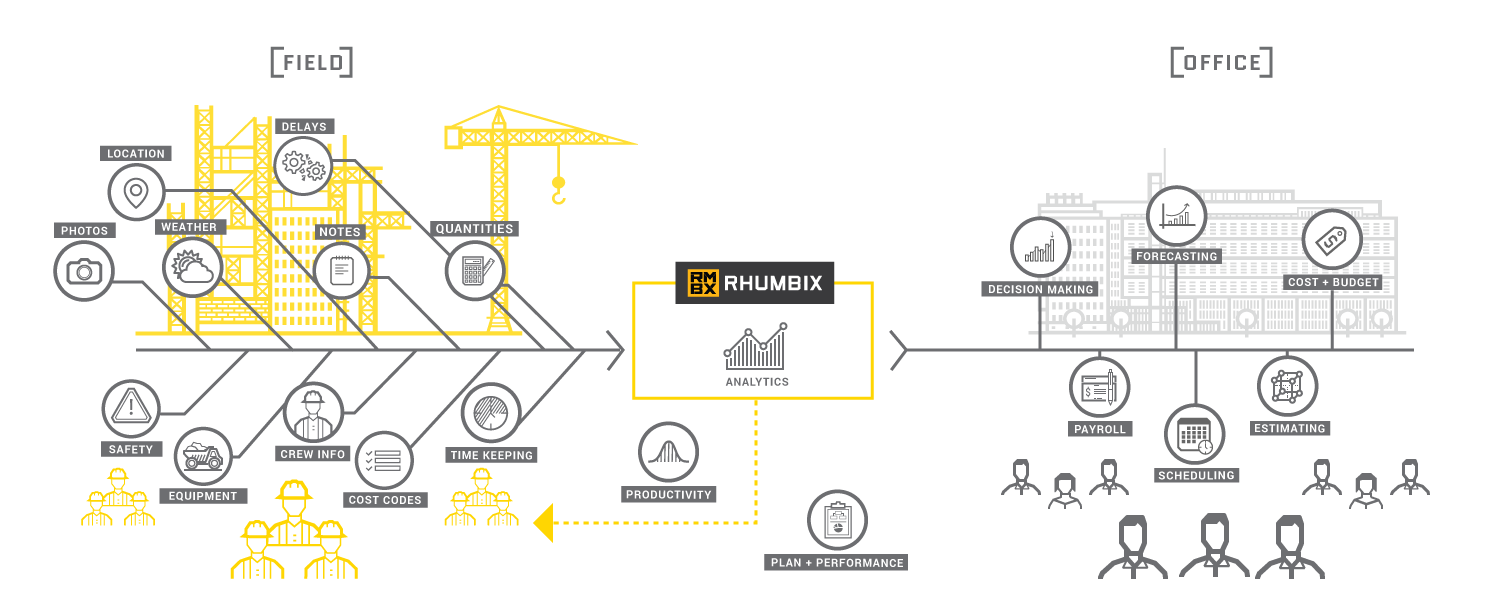Hard hats, high vis and smartphones – the digital response to construction’s greatest problems

A look into how a digital startup is improving productivity, on-time delivery and budget performance in the construction industry
An industry falling behind
The construction industry is acutely challenging to operate in. It is characterised by aggressive procurement, low workflow visibility, a limited supply of high quality talent, and low margins.
These combined factors have led to a lack of investment and hence a productivity gap. 74% of industry professionals believe that productivity growth is a challenge requiring changes in behaviour of all industry stakeholders[i]. Exhibit 1 shows us that this concern has materialised through construction productivity lagging behind the rest of the economy, and Exhibit 2 shows the fallout of this in driving extensive time and cost overruns.
Exhibit 1: Construction versus total economy productivity over time[ii]
Exhibit 2: Cost and time over-runs are the norm in the construction industry[iii]
One particular feature of this lack of investment has been the limited uptake of technology in construction. Spending on information technology accounts for less than 1% of the industry’s revenues, such that across 22 industries by digitization, construction ranks 21st [iv]. This presents an enormous opportunity – BCG estimates that through full-scale digitalisation, savings of 13 – 21% or $21bn per year globally could be materialised in non-residential construction[v].
Technology companies are just starting to respond to this. Amongst the expected highest impact and likelihood technologies to enter construction is real-time mobile collaboration[vi]. Until now, the industry has relied on paper processes for project management responsibilities such as procurement, cost coding, and time card allocation. As a result, information sharing is delayed, incomplete, and may not be delivered to the correct stakeholder.
Time for change – Rhumbix’s value proposition
Rhumbix, a workforce telematics company, is attempting to solve this problem through a digitised platform. Rhumbix hopes that through digitising project management, collecting, aggregating and analysing project data in real-time, it will be able to solve cost and time overruns that for so long have bogged the industry down. Rhumbix differentiates primarily through its platform, advance use of analytics including machine learning, and simple user interface. The role of Rhumbix can be depicted below in Exhibit 2.
Exhibit 3: Rhumbix collects, aggregates and analyses data for better project management[vii]
Before Rhumbix
With Rhumbix
For project managers, Rhumbix creates value in three areas[viii]:
- Reduced and improved administration: Rhumbix does the legwork on data collection and analysis and improves accuracy through simplifying data inputting
- Improved project decision making: Rhumbix supports daily updates on project profitability facilitating corrective action (see Appendix 1), and automated time and motion studies support improving site layout (see Appendix 2)
- Greater collaboration with the workforce: Managers can motivate their workforce through mobile dashboards, whilst delays can be identified immediately and obstacles removed
For workers, value is created in two ways[ix]:
- Improved site safety: Workers can input site safety observations for immediate response by managers
- Ease of reporting: Workers have instant access to cost codes and can report through a simple mobile interface
In order to capture some of this value, Rhumbix offers three differentiated tiers, each priced per craft worker / day, the lowest and middle tiers priced at 50¢ and $1 respectively, with the highest full service tier negotiated, and including full service analytics, and time and motion tracking.
Using digital to deliver value not before possible
Without a digital interface, Rhumbix’s operating model would not have been viable. Rhumbix has seized on the technological opportunity to deliver services including real time and accurate data, and a simple method for incorporating advanced analytics into project management, not previously possible.
Rhumbix ensures that workers do not reject this offering by anonymising worker level data and providing it in aggregate only at the crew level.
Cementing their market position
For Rhumbix to secure their position in the market, there are a number of next steps that Rhumbix should focus on:
- Scale rapidly: Rhumbix needs to become the number one provider in its field. Construction is a field in which workers regularly change company. As such there will be scale effects as with more workers using the app, more companies will want to use it to minimise worker learning/ramp-up costs
- Ensure cross-platform compatibility: As technology and its applications become more prevalent in construction, a critical component of Rhumbix’s success will be ensuring that it can integrate its functionality and data across platforms
- Expand functionality whilst maintaining simplicity: In order to take greater control over the market, Rhumbix should actively seek to expand its functionality, so that it becomes the ‘go-to’ app for project management
Through aggressive scaling and thoughtful design, Rhumbix will support it’s likelihood of succeeding in what is soon to become a highly competitive market. The hope for everyone is that accompanying the increase in technology adoption in construction will be a reduction in cost and time over-runs once and for all.
(788 words)
Appendix 1: Rhumbix application – Project profitability overview
Appendix 2: Time and motion studies can identify opportunities for site layout improvement
References
[i] Economist Intelligence Unit, (2015), Rethinking productivity across the construction industry: The Challenge of change, <http://damassets.autodesk.net/content/dam/autodesk/www/solutions/bim/images/stories/EIU_Autodesk_Construction_WEB.pdf>
[ii] Agarwal, R., Sridhar, M., Chandrasekaran, S., (2016), Imagining Construction’s Digital Future, <http://www.mckinsey.com/industries/capital-projects-and-infrastructure/our-insights/imagining-constructions-digital-future>
[iii] ibid
[iv] ibid
[v] Stewart, R. (2016), The Construction Business Goes Digital, <http://www.wsj.com/articles/the-construction-business-goes-digital-1474250580>
[vi] R de Almeida, P., Solas, M. Z., (2016), Shaping the Future of Construction: A Breakthrough in Mindset and Technology, < http://www3.weforum.org/docs/WEF_Shaping_the_Future_of_Construction_full_report__.pdf>
[vii] Rhumbix, (2016), Rhumbix is Workforce Telematics, <https://www.rhumbix.com/>
[viii] ibid
[ix] ibid









Hi Shaun, nice post! You’ve really “built” a strong argument for why digital transformation is needed in the construction argument. I was actually introduced to Zach Scheel, the CEO of Rhumbix back when I was first applying to business school as he is a fellow Navy vet. I think he is a great example of someone operating in an analogue and inefficient industry who has the insight to apply basic and commodified technology — like that inside iPhones — to do the job better.
I’d be interested in hearing more about (1) how Rhumbix delivers its promised value to construction companies and (2) what sort of advantage Rhumbix has that would prevent large construction companies from developing proprietary software guaranteed to link seamlessly with existing infrastructure?
Once again, great topic.
Echoing Nathan’s post, this is a very interesting a relevant topic. Having recently been involved with a construction project for a former school of mine (building opened in August 2016), I’ve come to appreciate the critical nature of communication across all parties, and how easy it is for miscommunication. Just like appointing a “point person” or liaison for job sights and offices, an app like Rhumbix would simplify communication greatly both in terms of time and complexity. Another consideration would be what platform this app would be used on: personal smartphones? What if certain workers don’t have smartphones? Laptops? They would have to be rugged enough, such as the Panasonic ToughBook. Also, it would be important to standardize the app for all circumstances, but the unpredictable nature of construction would also require the app to have enough flexibility to allow workers to input “unique” situations that require management feedback.
Hey Shaun – great post. Definitely the construction industry needs digitalization in order to help it be more profitable, stay on schedule and increase productivity. Construction is the beginning of economic development and a sign of prosperity of a nation.
The question here is, how do we expand Rhumbix for as many construction companies as possible? The problem with construction is that surely there are many qualified EPC’s who have mastered project management but many smaller construction companies in the developing world have not.
Could Rhumbix actually convince the project owner instead of the builder?
Many different business models can work.
Thanks for the introduction to this great topic!
Great post Shaun! I wonder if Rhumbix could make a case for targeting companies that specialize in overseas construction. In the face of softening demand for these services, Korea’s Minister of Land, Infrastructure, and Transport said “Korea’s construction players should switch to high value-added sectors like project planning and management rather than simply executing the orders they have received” [1]. Rhumbix seems like it could add tremendous value here by allowing Korean construction companies to work smarter, not harder in order to boost profits.
[1] http://www.koreatimes.co.kr/www/news/biz/2016/03/488_199598.html
Shaun, thanks for the introduction to Rhumbix. As I was reading your value proposition to workers, I thought back to Anglo American and Cynthia Carroll: is there a synergy for how Rhumbix could help actively impact worksite safety, both for injury prevention as well as resource and time loss? Increased reporting times are certainly important, analogous to decreasing lead times in a supply chain, I am sure they work well to make sure that dangerous features or behaviors are curbed. Perhaps Rhumbix could combine with certain RFID or BLE technologies to develop sensor/actuator active prevention in the field, to even catch near-miss incidents that are not derivative of operators cutting corners. In line with the IOT revolution and connected devices permeating every part of working life, do you think these devices and project work flows will be able to move between worksites or will they simply become entrenched within the construction itself? Rhumbix certainly looks well poised to continue to grow market share and explore these questions.
I’m bullish on the opportunity for digital disruption in the construction industry, but a bit skeptical that Rhumbix will be on the one to capture that value. Rhumbix seems to require significant data logging and site visibility in order to provide value to its customers – creating a pretty big behavior change challenge. I’m more excited about several drone analytics startups that are providing a birds-eye view of progress and problems on construction sites. The advantage that these startups have is that low-cost drones make it incredibly cheap to survey a construction site and provide real-time visibility of where work is progressing on schedule or falling behind, without requiring a construction site foreman to enter information. Drone surveying is also proof against falsified data or overly-rosy progress reports – in truth a single drone-picture is worth a thousand words, or a thousand-hours of data logging.
Wow, it’s incredible to see how mobile technology is making a difference in a traditionally hands-on, machine heavy industry. I’m particularly inspired by Rhubix’ ability to improve worksite safety and am reminded of the case we recently read on the unfortunate fatality rates in mining. I would challenge Rhubix to expand its focus from enabling efficient project management at construction sites to providing critical mapping and real-time data to improve safety at sites for oil, mining, disaster relief and rescue efforts. I think its existing technological infrastructure can be leveraged to create effective solutions for these use cases, too. For Rhubix’ current solution, I think one of its key benefits for general contractors is the cost/budget tracking and delay management. Many projects are at risk of going over budget midway. Rhubix could help contractors make better decisions around raw materials procurement during a project by flagging these costs and modeling several ways for them to save money by switching to another supplier. Rhubix could partner with its suppliers to provide real-time price data and receive a share of resulting profits.